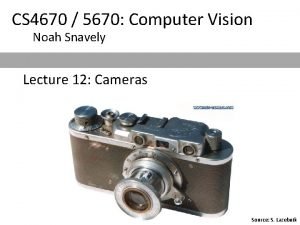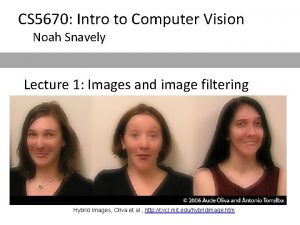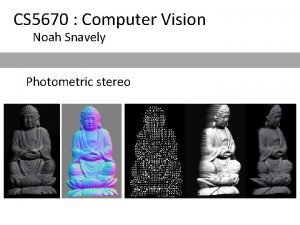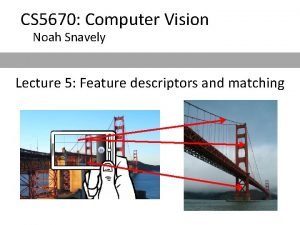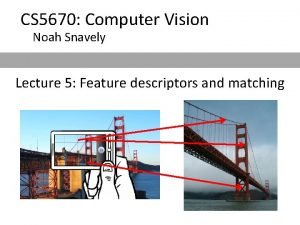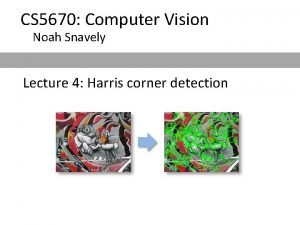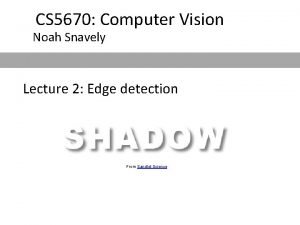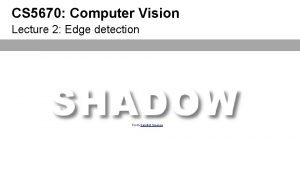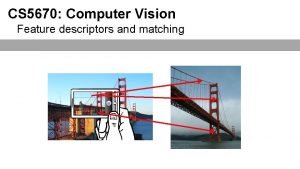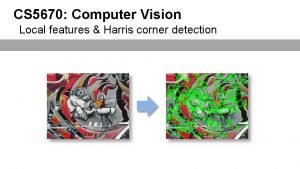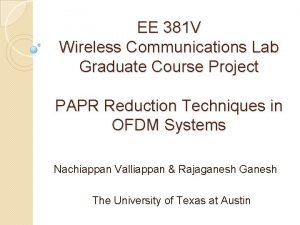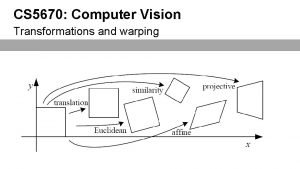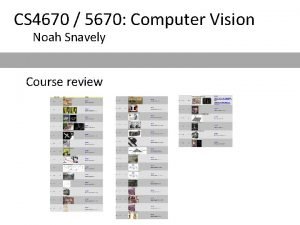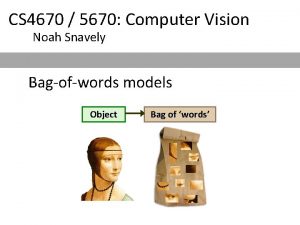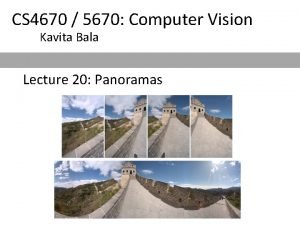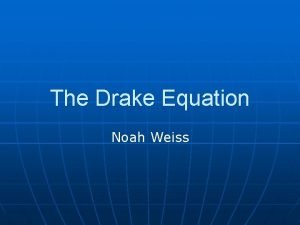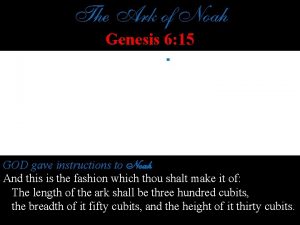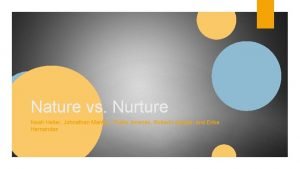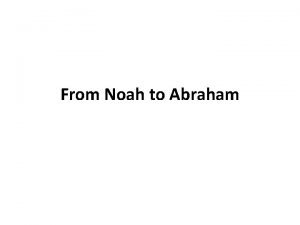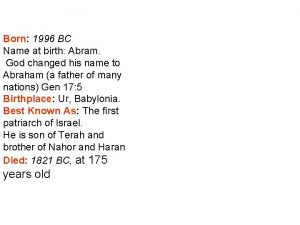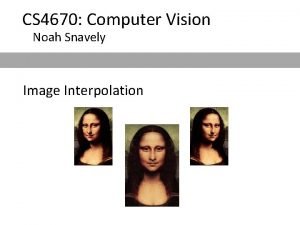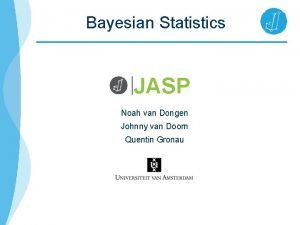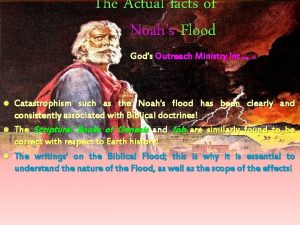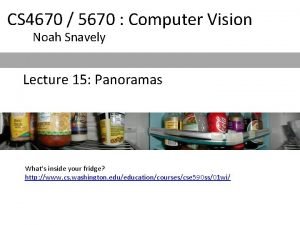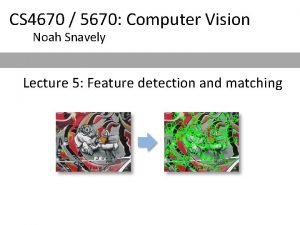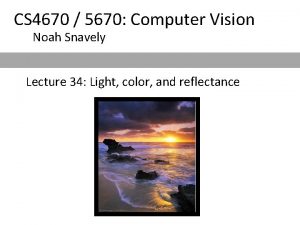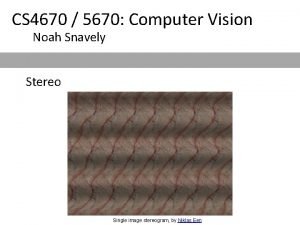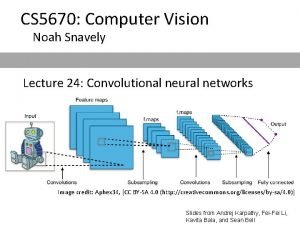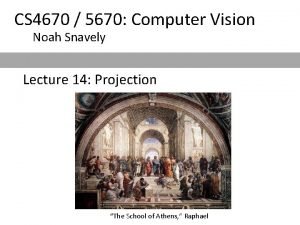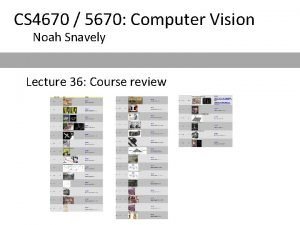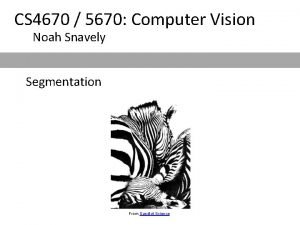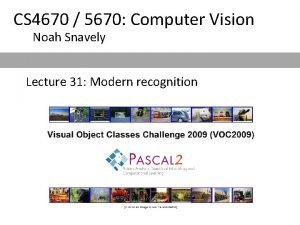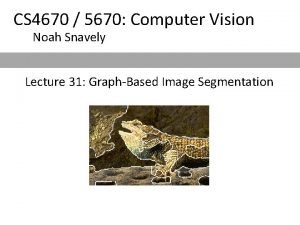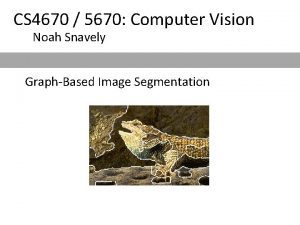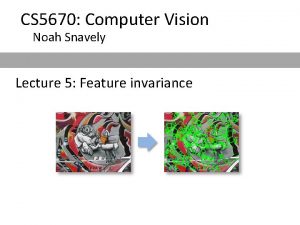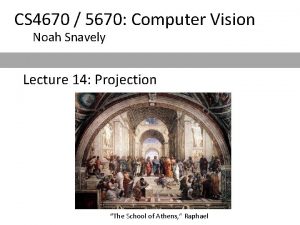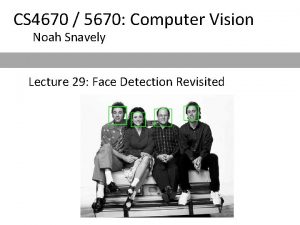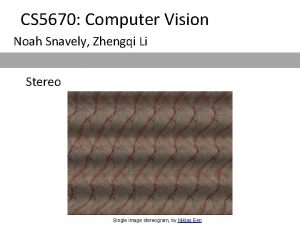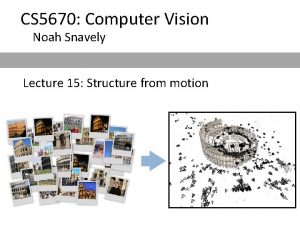CS 5670 Intro to Computer Vision Noah Snavely












































- Slides: 44

CS 5670: Intro to Computer Vision Noah Snavely Lecture 1: Images and image filtering Hybrid Images, Oliva et al. , http: //cvcl. mit. edu/hybridimage. htm

CS 5670: Intro to Computer Vision Noah Snavely Lecture 1: Images and image filtering Hybrid Images, Oliva et al. , http: //cvcl. mit. edu/hybridimage. htm

CS 5670: Intro to Computer Vision Noah Snavely Lecture 1: Images and image filtering Hybrid Images, Oliva et al. , http: //cvcl. mit. edu/hybridimage. htm

CS 5670: Intro to Computer Vision Noah Snavely Lecture 1: Images and image filtering Hybrid Images, Oliva et al. , http: //cvcl. mit. edu/hybridimage. htm

Reading • Szeliski, Chapter 3. 1 -3. 2

Announcements • You should all be enrolled in Piazza and CMS • Let me know if you need to be added

Announcements • Project 1 (Hybrid Images) will be released this week or early next week – Most likely on Thursday – This project will be done solo – The other projects will be done in groups of 2

What is an image?

What is an image? Digital Camera We’ll focus on these in this class (More on this process later) The Eye Source: A. Efros

What is an image? • A grid (matrix) of intensity values 255 255 255 255 255 255 = 255 255 20 0 255 255 255 75 75 75 255 255 75 95 95 75 255 255 96 127 145 175 255 255 127 145 175 175 255 255 127 145 200 175 95 255 255 255 127 145 200 175 95 47 255 255 127 145 175 127 95 47 255 255 47 255 74 127 127 255 255 74 74 74 95 95 95 74 74 74 255 255 255 255 255 255 255 (common to use one byte per value: 0 = black, 255 = white)

What is an image? • We can think of a (grayscale) image as a function, f, from R 2 to R: – f (x, y) gives the intensity at position (x, y) f (x, y) x y snoop 3 D view – A digital image is a discrete (sampled, quantized) version of this function

Image transformations • As with any function, we can apply operators to an image g (x, y) = f (x, y) + 20 g (x, y) = f (-x, y) • Today we’ll talk about a special kind of operator, convolution (linear filtering)

Filters • Filtering – Form a new image whose pixels are a combination of the original pixels • Why? – To get useful information from images • E. g. , extract edges or contours (to understand shape) – To enhance the image • E. g. , to remove noise • E. g. , to sharpen and “enhance image” a la CSI

Canonical Image Processing problems • Image Restoration – denoising – deblurring • Image Compression – JPEG, JPEG 2000, MPEG. . • Computing Field Properties – optical flow – disparity • Locating Structural Features – corners – edges

Question: Noise reduction • Given a camera and a still scene, how can you reduce noise? Take lots of images and average them! What’s the next best thing? Source: S. Seitz

Image filtering • Modify the pixels in an image based on some function of a local neighborhood of each pixel 10 5 3 4 5 1 1 1 7 Local image data Some function 7 Modified image data Source: L. Zhang

Linear filtering • One simple version of filtering: linear filtering (cross-correlation, convolution) – Replace each pixel by a linear combination (a weighted sum) of its neighbors • The prescription for the linear combination is called the “kernel” (or “mask”, “filter”) 10 5 3 0 4 6 1 0 1 1 8 0 Local image data 0 0 0. 5 0 8 1 0. 5 kernel Modified image data Source: L. Zhang

Cross-correlation Let be the image, be the kernel (of size 2 k+1 x 2 k+1), and be the output image This is called a cross-correlation operation: • Can think of as a “dot product” between local neighborhood and kernel for each pixel

Convolution • Same as cross-correlation, except that the kernel is “flipped” (horizontally and vertically) This is called a convolution operation: • Convolution is commutative and associative

Convolution Adapted from F. Durand

Mean filtering 1 1 1 1 1 * 0 0 0 0 0 0 10 20 30 30 30 20 10 0 90 90 90 0 20 40 60 60 60 40 20 0 90 90 90 0 30 60 90 90 90 60 30 0 90 90 90 0 30 50 80 80 90 60 30 0 90 90 90 0 20 30 50 50 60 40 20 0 0 10 20 30 30 20 10 0 0 90 0 0 0 10 10 10 0 0 0 =

Mean filtering/Moving average

Mean filtering/Moving average

Mean filtering/Moving average

Mean filtering/Moving average

Mean filtering/Moving average

Mean filtering/Moving average

Linear filters: examples * Original 0 0 1 0 0 = Identical image Source: D. Lowe

Linear filters: examples * Original 0 0 0 1 0 0 0 = Shifted left By 1 pixel Source: D. Lowe

Linear filters: examples * Original 1 1 1 1 1 = Blur (with a mean filter) Source: D. Lowe

Linear filters: examples * Original 0 0 2 0 0 - 1 1 1 1 1 = Sharpening filter (accentuates edges) Source: D. Lowe

Sharpening Source: D. Lowe

Smoothing with box filter revisited Source: D. Forsyth

Gaussian Kernel Source: C. Rasmussen

Gaussian filters = 1 pixel = 5 pixels = 10 pixels = 30 pixels

Mean vs. Gaussian filtering

Gaussian filter • Removes “high-frequency” components from the image (low-pass filter) • Convolution with self is another Gaussian * = – Convolving twice with Gaussian kernel of width = convolving once with kernel of width Source: K. Grauman

Sharpening revisited • What does blurring take away? = – (This “detail extraction” operation is also called a high-pass filter) Let’s add it back: = +α original detail smoothed (5 x 5) original detail sharpened Source: S. Lazebnik

Sharpen filter image blurred image scaled impulse unit impulse (identity) Gaussian Laplacian of Gaussian

Sharpen filter unfiltered

“Optical” Convolution Camera shake = * Source: Fergus, et al. “Removing Camera Shake from a Single Photograph”, SIGGRAPH 2006 Bokeh: Blur in out-of-focus regions of an image. Source: http: //lullaby. homepage. dk/diy-camera/bokeh. html

Filters: Thresholding

Linear filters • Is thresholding a linear filter?

Questions?
 Cs 4670
Cs 4670 Structured light
Structured light Cs 5670
Cs 5670 Cs 5670
Cs 5670 Cs 5670
Cs 5670 Cs 5670
Cs 5670 Cs 5670
Cs 5670 Cs 5670
Cs 5670 Cs 5670
Cs 5670 Cs 5670
Cs 5670 Harris matrix computer vision
Harris matrix computer vision Ee 381
Ee 381 Cs 5670
Cs 5670 Cs 5670
Cs 5670 Cs 5670
Cs 5670 Cs4670
Cs4670 Dr noah weiss
Dr noah weiss Noah's ark measurements
Noah's ark measurements Noah dunnett
Noah dunnett Noah cyrus again
Noah cyrus again Noah heath
Noah heath Nature vs nurture examples
Nature vs nurture examples Ararat anomaly google earth
Ararat anomaly google earth Shem
Shem Ayanda noah
Ayanda noah Noah hearing aid
Noah hearing aid Camp noah
Camp noah Abraham family tree
Abraham family tree Noah lockwood
Noah lockwood Noah mendelsohn
Noah mendelsohn Noah d. ellis
Noah d. ellis Noah's ark
Noah's ark Lemon sharks facts
Lemon sharks facts Noah
Noah Noah walcutt
Noah walcutt What noah escaped
What noah escaped Michelangelo meresi
Michelangelo meresi Arche bedeutung
Arche bedeutung Noah brocklebank
Noah brocklebank Noah was a drunk, abraham was too old
Noah was a drunk, abraham was too old Manifiesto ambiental de noah seattle
Manifiesto ambiental de noah seattle Noah van dongen
Noah van dongen Wie hieß noahs frau
Wie hieß noahs frau Will the nephilim return
Will the nephilim return Where is noah's ark now
Where is noah's ark now
